On & Off Campus
Bates begins the search for its sixth president.
Edited by H. Jay Burns
The Search Is On
The job—president of Bates College—has been held by only six people since 1855. In January, the Board of Trustees appointed a 15-member committee charged with managing the search for the seventh president in Bates’ 146-year history.
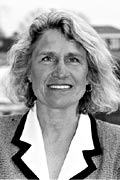
Karen A. Harris '74
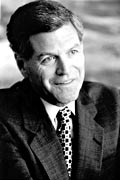
James F. Orr III P'94
“Bates is in a great position to begin the search for a new president,” said Trustee Karen A. Harris ’74, who is co-chairing the Presidential Search Committee with Trustee James F. Orr III P’94. “The College is stronger in every respect than it has ever been.”
The committee begins its work this spring and, with the assistance of an executive search consultant, expects to consider specific candidates in the fall. Finalists would be invited to campus in the winter, and the committee intends to make a recommendation to the full Board of Trustees for its approval no later than May 2002. The new president would take office in the following months.
Between now and this fall, the committee’s first job is to “define the profile and characteristics of what we—alumni, faculty, staff, and students—want in the next Bates president,” Harris said.
In a letter to the campus community, the co-chairs said that advice, views, and nominations from all areas of the Bates community will be “essential to our identification of candidates of intellectual distinction and accomplishment.” The highly confidential nature of the process, the co-chairs noted, will ensure a successful search for “proven leaders who can support the needs and values of the College and the resource initiatives so critical to our success.”
Joining Orr and Harris on the search committee are Trustees David O. Boone ’62, Ann E. Bushmiller ’79, J. Michael Chu ’80, Burton M. Harris ’59, Bruce E. Stangle ’70, and Catharine R. Stimpson H’90. Also on the search committee are Christopher Lee, the College’s director of human resources; Michael R. Bosse ’93, incoming president of the Alumni Council; and faculty members Lillian R. Nayder, associate professor of English; Joseph G. Pelliccia, associate professor of biology; Kirk D. Read, associate professor of French; and Mary T. Rice-DeFosse, professor of French. Student representation is to be announced.
Adam J. Garcia ’92, assistant dean of admissions, will serve as the search committee’s executive secretary and liaison to the Bates community.
For committee member and Trustee Burton Harris (who is no relation to Karen Harris), this is the second tour of presidential-search duty. Fourteen years ago, he chaired the search committee that yielded President Harward’s nomination. He remembers that “it was wonderful to see not only the number of people who sought the presidency, but also to see how talented and well-respected they were. The process verified our optimism about Bates. I expect the same this time—perhaps to an even greater degree.”
Burton Harris noted that “in a unique way, a presidential search lets you work with all College constituencies: faculty, staff, alumni, and students. There aren’t many other opportunities to focus the College’s energy to such a degree: identifying institutional strengths and weaknesses, and then identifying a person who will improve on the weaknesses and support the strengths. The president is the person who can do that more than any other.”
If history is any indication, a new president will follow the Bates tradition of principled, hard-working leaders, doggedly devoted to the College’s mission. The Rev. Oren Cheney, of course, founded Bates. Maine native George Colby Chase, his first teaching job in a one-room Thorndike schoolhouse filled with 60 children, rose to the presidency from the Bates faculty. Clifton Daggett Gray was a Baptist preacher, author, and editor. Charles Franklin Phillips, a Colgate economics professor, championed entrepreneurial spirit over “big business” at his 1944 inauguration. Thomas Hedley Reynolds, a World War II tank commander, was a history professor and later dean at Middlebury.
Philosopher Donald West Harward, who took office in 1989, founded the honors program at Delaware and came to Bates from the College of Wooster. President Harward steps down in June 2002.
Direct correspondence to the Presidential Search Committee: Bates College, 22A Coram Library, 42 Campus Avenue, Lewiston, ME 04240; e-mail presidential-search-committee@bates.edu; phone 207-753-6955; fax 207-753-6939; on the Web https://www.bates.edu/presidential-search.xml
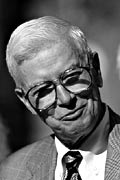
James L. Moody '53
A $1.5-million gift from James L. Moody Jr. ’53, chair of the Bates Board of Trustees and retired CEO and chairman of Hannaford Bros. Co., establishes the James L. Moody Jr. Family Professorship in the Performing Arts. “I hope I can encourage others to be as optimistic about Bates’ future as I am,” he said. “As the years pass, I have more and more appreciation for the possible infinite life of Bates. Compared to our lives, Bates’ life can be eternal.” In June, Moody will retire as chairman of the Board of Trustees, a position he has held for 14 years. “No role of institutional leadership is more important than that of being board chair,” said President Harward, who will retire himself in 2002 after 12 years as Bates College president. “Jim Moody has been a graceful and wise friend of the College and a resourceful and reliable partner in leadership. We are in his debt.”
Professor of Music James Parakilas, profiled in the fall 2000 Bates Magazine, has been appointed the inaugural Moody Family Professor of Performing Arts. His book, Piano Roles: Three Hundred Years of Life with the Piano, received glowing praise from The New Yorker, The New York Times, and the Los Angeles Times Book Review.
This year’s Martin Luther King Jr. Day observance at Bates had a family connection: the Rev. James F. Reese was one of three panelists who led the keynote discussion on “King and the Campus: Voices of the Movement.” Proudly introducing Reese—”my dad”—was his son, James L. Reese, associate dean of students. The elder Reese is the retired director of the Racial Ethnic Ministry Unit for the Presbyterian Church. While pastor of the First United Presbyterian Church at Knoxville (Tenn.) College from 1959 to 1967, the elder Reese led sit-ins protesting Jim Crow laws and practices.
Amanda Colby ’00 of Willimantic, Conn., was among 10 finalists for NCAA Woman of the Year, an award that honors senior student-athletes for academic achievement, athletic excellence, service, and leadership. One of 51 state winners, Colby and the other finalists were recognized at the NCAA Woman of the Year awards dinner last fall.
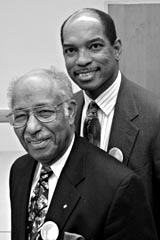
Associate Dean of Students James J. Reese welcomed his father, the Rev. James F. Reese, at this year's MLK Day ceremonies.
William Stringfellow ’49 began his activism at Bates in the 1940s by organizing a sit-in at a nearby restaurant that refused to serve blacks. A Harvard-educated lawyer who studied at the Episcopal Divinity School, his writings form a significant chapter in the canon of the American peace movement. President Harward noted that “he offered his service to the frightened, the defeated, the angry, the have-nots.” Stringfellow who died in 1985, will be memorialized with an annual Bates award established by the Chaplain’s Office to recognize a Bates student and a Maine citizen whose lives and work have been dedicated to the promotion of peace and justice.
A granite monument to the late Ed Muskie ’36 was dedicated last summer in Muskie’s Rumford hometown. Muskie, a former Maine governor, U.S. senator, presidential contender, and U.S. secretary of state, died in 1996 at age 81. Former U.S. Sen. George Mitchell eulogized Muskie as “hero, mentor and friend.” Mitchell observed how fitting it was that the granite monument stands beside a beautiful pool of the Androscoggin River, a section now home to trout and landlocked salmon. When Muskie was a boy, the polluted river was what many people accepted as the inevitable price of economic prosperity. “He made people realize they didn’t have to live that way,” Mitchell said. “He created a national consciousness, then set about to devise a solution.” Eight out of 10 U.S. rivers were badly polluted three decades ago. Today, thanks in large part to Muskie’s effective lawmaking, Mitchell said, only about 15 percent are as polluted.
The Maine Development Foundation (MDF) presented its 2000 Champion for Economic Growth Award to Bates. The award cited Bates, under the direction of President Harward, for strengthening its relationship with the Lewiston–Auburn community.
Author Elizabeth Strout ’77 saw her prose transformed for the small screen in March with the ABC telecast of Ophrah Winfrey Presents: Amy & Isabelle, an adaptation of Strout’s best-selling debut novel. The film, with Elisabeth Shue (Leaving Las Vegas, Hollow Man) and Hanna Hall (The Virgin Suicides, Forrest Gump) in the title roles, was a production of Oprah Winfrey’s Harpo Films.
Made possible through family gifts in memory of the late College Trustee and Maine tennis champion, the eight-court James G. Wallach ’64 Tennis Center was dedicated last fall. Each of the courts features tournament-quality lighting, Plexi-Cushion hard court surface, and stadium seating for 75 to 100 spectators. Six of the courts can be seen from a 25-foot-high tennis house with a viewing deck and tournament desk for the coaching staff.
Bates joined with Bowdoin and Colby colleges to introduce Maine’s first statewide online library catalog in January. The state-funded Maine Info Net system makes the CBB library collections, with more than two million items, available to participating libraries throughout Maine.
Meanwhile, Professor of Russian Jane Costlow is the inaugural Christian A. Johnson Professor of Interdisciplinary Studies, an endowed professorship made possible by a $1.2-million grant from the Christian A. Johnson Endeavor Foundation of New York City. Her recent scholarship focuses on the significance and symbolism of the forest in Russian history, and her award-winning translation of The Tragic Menagerie, a rediscovered Russian novel, received critical acclaim.
Following an October weekend in which alcohol played a role in a post-game fracas between Bates and Colby football fans and several cases of alcohol poisoning occurred at a Halloween party, the Office of the Dean of Students banned hard alcohol from campus. With a similar ban in effect at Bowdoin, Bates is not alone in facing down the issue of reckless drinking on campus. Throughout the winter, a campus committee continued discussions of how to alter the alcohol culture at Bates.
Following the stunning success of Pettengill Hall and Perry Atrium, Bates has again retained Shepley Bulfinch Richardson and Abbott Architects to help with a major building project. The design firm will consult on the College’s next wickedly complex project: a new campus center. The project promises to be challenging because of the additional need to renovate and expand dining spaces. Whether that expansion occurs within Chase Hall or in a new campus center is up for extensive discussion.
History was made in November, when a male caller phoned in a bomb threat—believed to be the first ever at Bates. The caller said an explosive device was in Pettengill Hall, but a search by Security and Lewiston police turned up nothing, though the building was closed much of the day.
While many of us talk to our computers, Sameer Raj Maskey ’02 is inventing ways to make his computer talk back. Maskey, a Nepal native, is working on the first ever text-to-speech software for the Nepali language. Such software allows a computer to “speak” words a user types on the keyboard. To make synthesized speech natural sounding, Maskey had to create effective prosody parameters. In other words, he has to play Henry Higgins to his computer’s Eliza Doolittle. “A computer needs to know what the real sounds of the words are, the rhythm, intonation, and flow of the sentence,” he said. When Maskey needed help from leading specialists in language synthesis, he pursued summer research at Carnegie Mellon University and three other schools. Bates grants from the endowed Sigety Family Fund for Computer Science and the Linda Erickson Rawlings Student Research Fund, paved the way.
Wouldn’t it be nice, once again, to be able to say, “My Bates professor recommended this book”? Then check out the annual “Bates College Store Non-Required Reading List.” Edited by store manager Sarah Potter ’77, the list has book suggestions from various Bates faculty and staff—including the College’s lawyer, John B. Cole. Click on www.bates.edu/admin/offices/collegestore/reading.html.
When Midwest states argue about water rights, watch out. The bickering can be as bad as a dispute about college football bragging rights. So says Vincent McKusick ’44, retired chief justice of the Maine Supreme Court. He’s been appointed a “special master” by the U.S. Supreme Court to settle an interstate dispute between Kansas and Nebraska. In the suit, Kansas says that Nebraska, by allowing unrestricted well drilling in the Republican River basin, has violated a compact among the two states and Colorado that allocates water use from the river, which runs through all three states. “My role is somewhat the same as a trial judge’s,” McKusick said, “but my decision is in the form of a recommendation to the U.S. Supreme Court.” The Supreme Court has named only four special masters since 1992, and McKusick has now earned three of the appointments.
Camille McKayle ’85, professor of mathematics at the University of the Virgin Islands, was one of six teachers nationally to receive a millennium award for teaching excellence, sponsored by the White House Initiative on Historically Black Colleges and Universities organization. At Bates, she saw the value of faculty involvement with students: “It makes me want to do that with my students,” she said.
Stimuli, an exhibition of art theses in progress, attracted a packed house at the Ronj coffeehouse last fall. Greeting attendees on the front lawn was a giant smoking cigarette, a piece created by Duncan Murdoch ’01 of Shelburne, Vt. Inside, 14 art majors had at least one work represented.
Thumbs-down to the state of Pennsylvania, which OK’d its first bobcat hunt in three decades. The October through February hunting and trapping season was expected to yield between 60 and 175 bobcats.
Safely in Lewiston, Bobcat men’s basketball players spent time on Jan. 3 visiting second graders at the Farwell School in Lewiston. They read aloud and worked on art projects to help “provide positive role models and help the students get excited about reading,” in the words of coach Joe Reilly. The players signed Bates schedules, which got the kids fired up, too.
Dan Doyle ’72 was one of four honorees at the Center for the Study of Sport in Society’s awards banquet in Boston recently. Former Boston Celtic great Bill Russell, Ross Greenburg of HBO Sports, and Ann Woolf, widow of the late noted sports agent Bob Woolf, joined Doyle, executive director of the Institute for International Sport, as honored guests.
Another recently feted alumnus was Jamie Merisotis ’86, who received the 2001 Community College Government Relations Award for his “passionate dedication to promoting equity and access on behalf of low-income and disadvantaged students.” Merisotis, founder and president of The Institute for Higher Education Policy in Washington, D.C., was honored by the American Association of Community Colleges and the Association of Community College Trustees.
At the Bates College Museum of Art last fall, a small exhibition and lecture on Cambodia came together “in a big way,” says museum director Genetta McLean, thanks to Dick Melville ’54. The exhibition featured rubbings and photographs—donated by Melville—from the ancient ruins at Angkor, Cambodia, which date from 879 A.D. Two of Melville’s longtime friends gave distinguished talks, one on “Angkor in 2000,” the other on “Cambodian Death Traps: It Won’t Be Easy to Get Out of Them and Why.” Art students taking a Buddhist art and architecture course (part of Bates’ newly invigorated East Asian art curriculum) prepared papers and wrote exhibition labels. Meanwhile, Trian Nguyen, the College’s Luce Junior Professor of Asian Studies, who teaches several new Bates courses, invited the Cambodian community in Portland to attend.
When a Stars and Stripes article noted the 50th anniversary of the battle of Hill 180 during the Korean War, the piece focused much of its attention on the hero missing from the ceremony: Lewis Millett ’49, who received the Medal of Honor for his action in the battle. In seizing the strategic knoll on Feb. 7, 1951, Millett led what has been called the last and greatest bayonet charge since Cold Harbor in the Civil War. Millett, a retired Army colonel, lives in Idyllwild, Calif., and wasn’t up for the trip to Korea. Reached by phone, he remembered his Bates days (Millett was a 24-year-old World War II veteran when he entered Bates). “I remember that the girls always used to get the best scholastic marks at Bates. But when the veterans came back, we started started getting the best marks,” he said. “But we agitated too. Freshmen had to wear those dinky little hats [beanies] but there was no way the veterans were going to!”
The Barlow Alumni Travel Grant
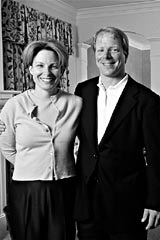
David '79 and Ann Barlow
Thanks to the generous endowment gift by David ’79 and Ann Barlow (reported in the fall 2000 magazine), Bates study abroad isn’t just for students anymore.
The new Barlow Alumni Travel Grant is an award of up to $3,000 to fund travel abroad by a Bates alumnus/a involved in K–12 education who has been teaching at least five years. The travel grant supports educational and professional goals.
The grant will be available annually starting in June 2001. Application forms are available through www.bates.edu/alumni, and application deadline is May 15.
The Barlow Endowment also funds a range of study-abroad programs for students, as well as opportunities for students to link their experience more closely with their academic program, and to share their experiences with the campus community.
While at Bates, David Barlow spent a transformational junior year at the University of Wales and traveled throughout Europe and North Africa. “The trains were my classroom,” he said. The experience “liberated my curiosity and ignited a hearty appetite for diversity and global citizenship.”
Bates in the News
“With 4,400 applicants last year for just 465 seats in the entering class, Bates College in Maine is one of America’s most selective schools,” said the lead in the education story in The Times of London. Both Dean of Admissions Wylie Mitchell and Vice President for External and Alumni Affairs Bill Hiss ’66 were quoted prominently in the piece, which ran Dec. 29. Hiss said that the personal “packaging” that some firms provide to prospective students for America’s most selective colleges “runs at cross-purposes to what these kinds of colleges are supposed to be doing, which is helping young people think honestly about who they really are.”
Bates’ service-learning program has been lauded as an example for the country in two recent national articles, one in The Chronicle of Philanthropy and the other in The Christian Science Monitor. “As colleges have increasingly incorporated community-service projects into their missions, Bates has been one of the leaders in such efforts, offering its students a range of incentives,” the Nov. 30 Chronicle article said, “including course credit, administrative support, special housing accommodations, and money.” The full story can be read at http://philanthropy.com/free/articles/v13/i04/04003201.htm.
In its Dec. 12 issue, The Christian Science Monitor higher education writer Mark Clayton conducted a brief but broad-ranging interview with President Donald Harward. The discussion focused on the particular value of a liberal arts education, and the linking of academic rigor with service to community.The Monitor story can be viewed at http://www.csmonitor.com/durable/2000/12/12/fp15s1-csm.shtml.
Georgia senators Max Cleland and Zell Miller recently announced plans to introduce a U.S. Senate resolution urging President Bush to award the Presidential Medal of Freedom to the late Benjamin Mays ’20. Mays, a child of freed slaves, was a noted human rights advocate and president of Morehouse College. He influenced a generation of civil rights leaders, and the Rev. Martin Luther King Jr. described Mays as “my spiritual mentor and my intellectual father.”
“As time goes on, Dr. Mays continues to stand out as an incredible example of faith and belief in America and the American dream,” Cleland, a Democrat, told the Atlanta Journal and Constitution recently. “Plus, he was a civil and human rights leader and a public theologian. He just was an incredible human being.” The Presidential Medal of Freedom honors those who have made especially meritorious contributions to national security, world peace, or cultural, public or private endeavors.
Amid speculation that Al Gore might wind up with the Harvard presidency, The Boston Globe wondered whether Gore could add to Harvard’s reputation. Professor of Political Science Doug Hodgkin offered this dry assessment: “I don’t know if Harvard needs any additional prestige. It’s more likely that Gore would get prestige from the school.”
Senior Victoria Wyeth was featured in Victoria magazine on the exhibition she developed at the Bates College Museum of Art of grandfather Andrew Wyeth’s creative process in painting Her Room. In his review for the Maine Sunday Telegram, Phil Isaacson ’47 applauded Victoria’s black-and-white photographs of her grandfather that accompanied the exhibition: “She has an eye for the characteristic moment, and that gives the artist a tangibleness rather than the abstraction of a public moment.”
The Rhetoric vs. Reality of Bates History
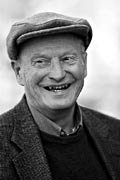
Charlie Clark '51
Charlie Clark ’51 has been sifting through documents, letters, and photographs in the Muskie Archives and Special Collections Library, searching for “illustrative moments and events” that define Bates history. In preparation for its sesquicentennial celebration in 2005, the College invited Clark, author and professor emeritus of history at the University of New Hampshire, to write a selection of historical Bates essays, to be published in book form in summer 2002.
Bates History 101 says the Freewill Baptists who founded Bates in 1855 envisioned a school where kids from rural New England could get an affordable education. One of the questions Clark hopes to explore is how those founding ideals of democracy and hard work have evolved over time.
In the early 20th century, he explained, those ideals were exemplified by campus literary societies. Open to everyone, the societies—which occupied Libbey Forum—offered a public arena for debates, discussions, and readings among students. “It was solid, academic stuff going on in those societies,” Clark said. “It was really a part of one’s education.”
In some cases, said Clark, the ideals of democracy and equality seemed “more rhetoric than reality.” Although Bates was founded as a coeducational school, women were not always treated equally. In the early 1900s—before Bates allowed dancing on campus—men were free to attend dances downtown. Women required permission. Up until the 1960s, campus policy held women to stricter standards. “Women couldn’t go away overnight without permission, couldn’t go into men’s dorms, couldn’t smoke in public,” said Clark. While women had housemothers to supervise their dorms, the men had maids to sweep their floors and change their bed sheets. (Women, of course, were expected to clean their own linens.) By including the unflattering alongside the glorious, Clark aims to present an evenhanded Bates history. “I don’t want to make it seem like propaganda,” he said.
As comprehensive, connect-the-dates college histories are rarely undertaken these days (Bates’ last history was in 1936), Clark’s book will not “fill out the historical record.” Combining historic and contemporary photos with descriptive essays, it will be organized into nine chapters addressing such topics as the curriculum, college life, and Bates in wartime. Clark hopes to present Bates’ history by discussing definitive episodes that altered campus life. In the curriculum chapter, for instance, Clark plans to use the implementation of President Phillips’ “Bates Plan” in the 1940s—a dramatic shift in educational practices—as a way to explore trends that shaped the College’s curriculum.
Clark is used to sifting through historical minutiae to gain fascinating insights. His 1998 book, The Meetinghouse Tragedy: An Episode in the Life of a New England Town, told the tale of the collapse, during frame raising, of a Wilton, N.H., meetinghouse in 1773 that killed five men and injured 48. Clark researched the tragedy, and his book gives insight into architectural history, popular and folk culture, religious traditions, and small-town life in Colonial New England.
Clark’s Bates history will be published in summer 2002. Besides offering nostalgic alums the opportunity to beef up on their Bates trivia, what’s going to make this history appealing? “Well, the pictures are going to help but I hope I’m not a totally dull writer,” Clark said.
—Jennifer Giblin ’01
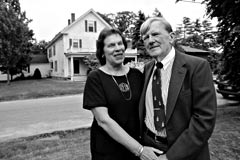
Robert '50 and Gladys Bovino Dunn '51 stopped by 40 Mountain Ave. last June prior to renovations to create the Dunn Guest House.
Standing next to historic Libbey Forum, the 19th-century farmhouse at 40 Mountain Avenue is now undergoing extensive renovations for use as the official—and first ever—Bates College guest house.
The residence will take its place in Bates history at Reunion in June, when it is christened as the Dunn Guest House, in honor of Robert Dunn ’50, L.H.D. ’99 and Gladys Bovino Dunn ’51 of West Hartford, whose leadership gift has funded the renovations.
The house, long part of Bates and one of the oldest residences near campus, was owned by Professor of Mathematics George Ramsdell ’03 and his family for 67 years, beginning in 1910. (Prior to Ramsdell, the owner was longtime professor Herbert R. Purinton: the fourth generation of the Purinton family graduated from Bates in 1998.)
When Ramsdell died in 1958, Harry Rowe ’12 wrote in the Alumnus that the professor’s “support of alumni activities was constant and ready. His home was the focal point for reunions. His sister, Mary J. Ramsdell ’05, and his second wife, Harriet Johnson Ramsdell ’16, will continue to live at 40 Mountain Avenue, where they will always be glad to see ‘Prof’s’ old students.”
Bates bought the property from the Ramsdell family in the 1970s and hoped to use the house for faculty offices, to alleviate overcrowding in next-door Libbey Forum. But Mountain Avenue neighbors vigorously opposed the move, and Bates failed to receive the needed zoning permission. The house was then the campus residence of treasurer Bernard Carpenter and his family from the late 1970s until recently, when Carpenter retired.
Bates has never had a guest house for campus visitors. Bob Dunn, a career secondary-school educator in West Hartford, recalls visiting campus with prospective students and staying the night in Chase Hall. But those accommodations long ago were needed by student organizations. Over the years, College guests have made use of College apartments or local lodging.
The three-floor house will offer five guest rooms for special visitors, including honorary degree recipients, acclaimed speakers or performers, and other friends of the College. A three-room common space dominates the first floor, while the second floor features three bedrooms. The third floor features a suite of rooms. A handicapped-accessible room will adjoin the main building on the first floor.
The Dunns were pleased that Bates found a welcoming house, steeped in Bates tradition, in an older part of campus, “where people could enjoy the beauty of the campus and the traditional Bates hospitality,” Bob said. “We envisioned something where people could stay that was a little nicer.”
Bates architect Pam Wichroski is directing renovations. With a gracious entryway, fireplace, and hardwood floors, the first floor and its long, outside porches and sizeable back lawn, should set a high standard of comfort for guests of the College, Wichroski said.